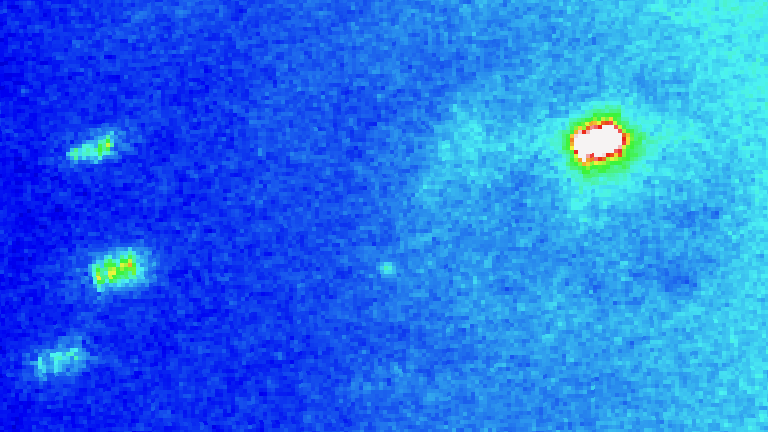
Comet C/2021 O3 due to sweep past
A comet discovered last July is approaching the inner solar system and might reach binocular visibility (at least) by late April and early May 2022. It’s designated C/2021 O3 and appears to be “new” to the inner solar system, a first-time visitor. In fact, it’s taken perhaps millions of years to arrive here from the outer part of the Oort cloud. Its orbit appears hyperbolic.
Basically, that means it might have just enough escape velocity, after it sweeps near our sun this April, to break the bonds of our sun’s gravity. If so, unless it’s perturbed by a larger body (such as Jupiter), it stands a chance of veering into the wider space of our Milky Way galaxy after it sweeps past our sun … never to return. Many on Earth will glimpse this traveler. See charts below.
Or, as some comets do near the sun, Comet C/2021 O3 might disintegrate when nearest our star. This comet is expected to pass at 26.6 million miles (42.8 million km) from the sun. For comparison, the average distance of our sun’s innermost planet, Mercury, is 36 million miles (58 million km) from the sun. So – given that Mercury’s sunny side reaches temperatures of around 750 to 800 degrees Fahrenheit (up to about 430 degrees Celsius) – you can see that Comet C/2021 O3 (PanSTARRS) will really feel the sun’s heat.
The 2022 lunar calendars are here. Order yours before they’re gone!
Visible in May?
If it survives its April 2022 passage near our star, Comet C/2021 O3 might become visible to amateur stargazers armed with binoculars in May. At that time, it’ll be in front of the constellation Perseus the Hero, close to the northwestern horizon after sunset. As of now, the best dates to try to spot the celestial visitor should be around May 3 to 7, 2022. See the charts below.
Observations of the comet as it has barreled from deep space toward the inner solar system have let astronomers calculate its orbit with some precision. As of now, we know its perihelion (closest point to the sun) will be April 20-21, 2022. Shortly afterwards – on May 8, 2022, at 18 UTC – the comet will be closest to Earth at 50.9 million miles (82 million km) from Earth. That’s not at all close. In fact, it’s about 200 times the moon’s distance!
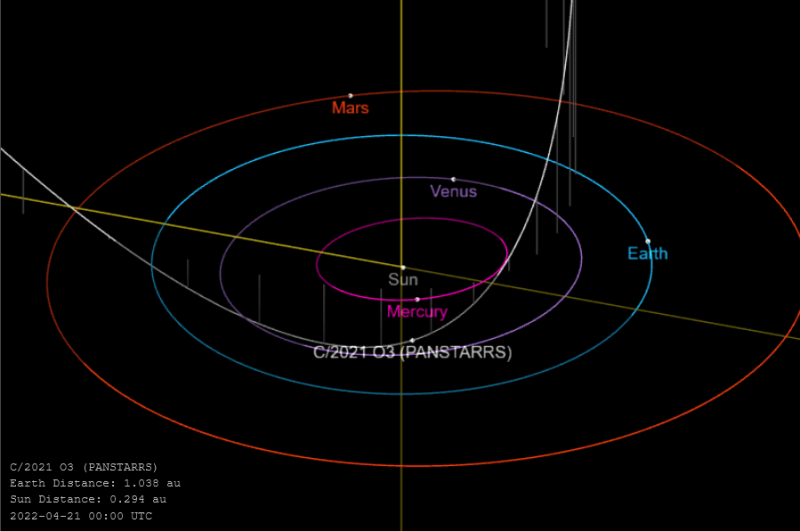
A brief history of Comet C/2021 O3
Scientists first observed C/2021 O3 (PanSTARRS) on July 26, 2021. They were using the 71-inch (1.8-meter) Pan-STARRS 1 telescope in Hawaii. Ultimately, they found it in the direction of our constellation Pegasus the Winged Horse (see the Facebook post below). And, they found it when it was still 4.3 astronomical units (AU) from the sun (more than four times Earth’s distance).
Later, the IAU Minor Planet Center in Cambridge, Massachusetts designated it as Comet C/2021 O3 (PanSTARRS) on August 1, 2021.
So, why do amateur astronomers hope to see this comet? It’s because – shortly after its discovery, when it was still very far from the sun – confirmation images showed a compact coma or cometary atmosphere (see image above) for this comet. Usually, a comet’s coma typically doesn’t appear until a comet sweeps nearest the sun. In this case, the presence of a coma for a faraway object suggested to astronomers that it’s big and might become bright.
Relatively bright, that is.
Will it be visible to the eye?
Comets are unpredictable. And it’s likely C/2021 O3 (PanSTARRS) will not become visible to the eye. However, it might become a binocular object. And, it’s too early to know what to expect from this new comet. One thing we do know is that the comet will be close to the sun when brightest. So observers will need an unobstructed view to the northwest horizon to glimpse it in late April and early May, shortly after sunset.
So, observing Comet C/2021 O3 (PanSTARRS) will become possible in late April and will slightly improve by early May. Even if we are able to see this comet with binoculars, it’s possible (perhaps likely) that this celestial visitor will make a brief appearance in the skies of amateur observers … perhaps for only a few days.
Generally, predicting how bright a “new” Oort cloud comet may appear is very difficult. Calculations indicate it might reach magnitude 7 or 6 (lower numbers are brighter). Other estimates, however, suggest Comet C/2021 O3 (PanSTARRS) might appear even fainter, at around magnitude 8 or 9.
With that in mind, you shouldn’t get too excited if you see some claims that a bright comet is coming. The word bright, in the world of astronomy, is always relative. Most comets do require optical aid.
By the way, whether Comet C/2021 O3 disappoints, or not, there’s another comet discovered by the same observatory in Hawaii that might provide nice views for observers using small backyard telescopes during this upcoming summer. That other comet is called C/2017 K2 (PanSTARRS).
Keep watching the sky!
Charts for April and May, 2022
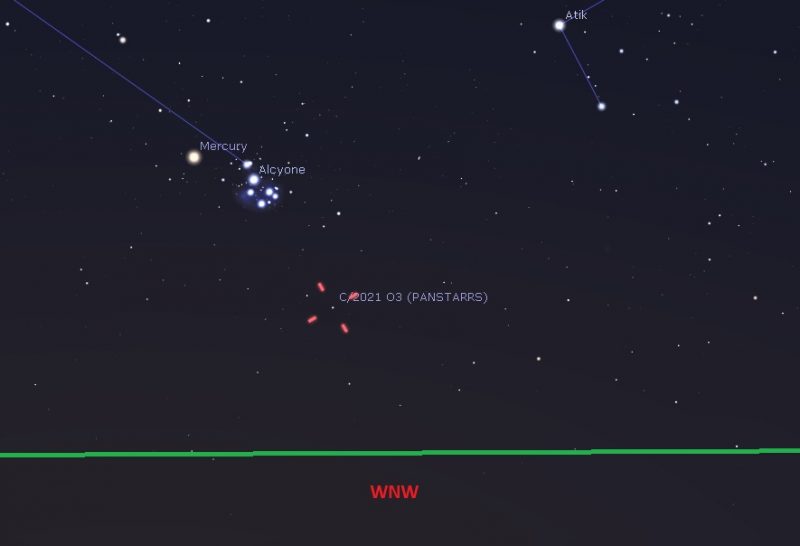
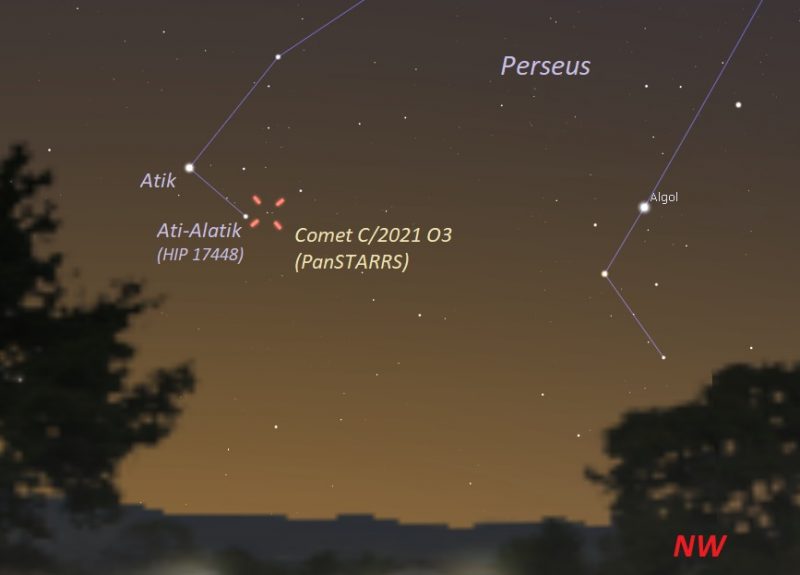
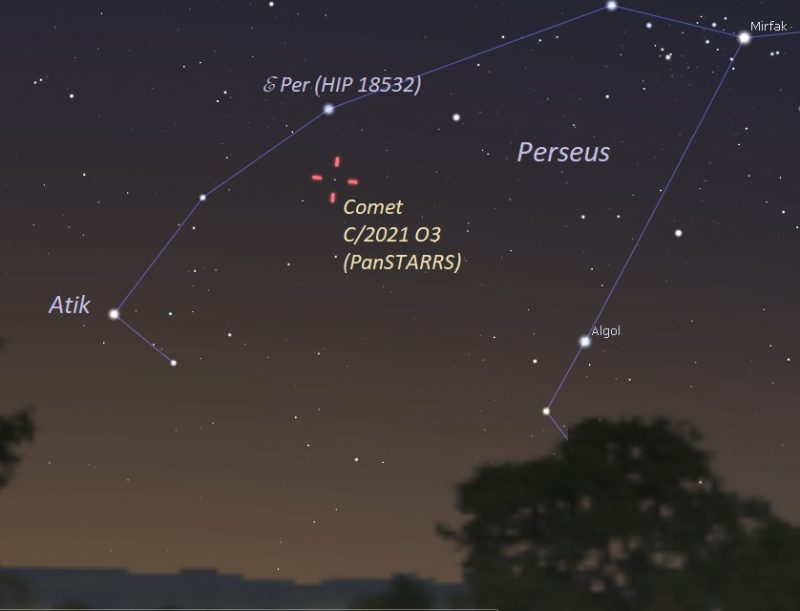
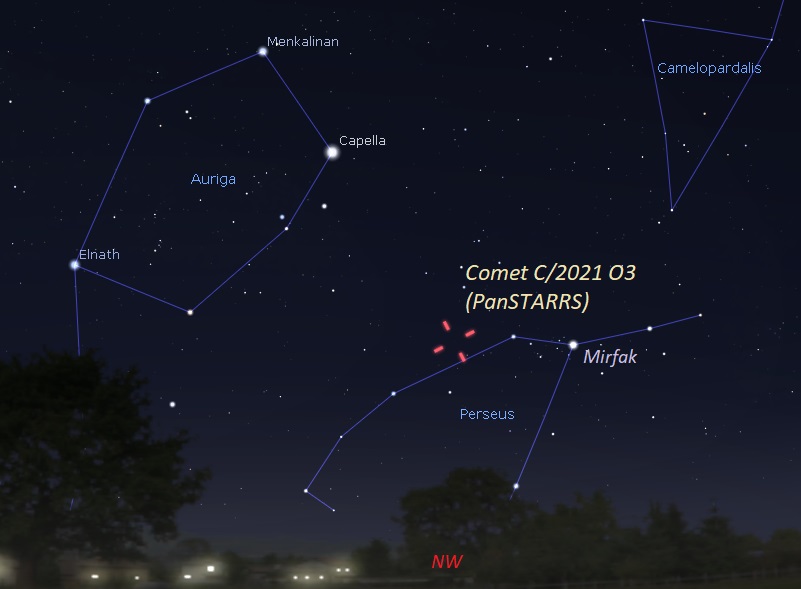
Bottom line: A new comet named C/2021 O3 PanSTARRS will visit the sun and be closest to Earth in the spring of 2022. It might become visible to the unaided eye.
Read: Large comet C/2017 K2 to pass Earth safely in July 2022
The post New comet C/2021 O3 might brighten in May 2022 first appeared on EarthSky.
from EarthSky https://ift.tt/3fFWrw2

Comet C/2021 O3 due to sweep past
A comet discovered last July is approaching the inner solar system and might reach binocular visibility (at least) by late April and early May 2022. It’s designated C/2021 O3 and appears to be “new” to the inner solar system, a first-time visitor. In fact, it’s taken perhaps millions of years to arrive here from the outer part of the Oort cloud. Its orbit appears hyperbolic.
Basically, that means it might have just enough escape velocity, after it sweeps near our sun this April, to break the bonds of our sun’s gravity. If so, unless it’s perturbed by a larger body (such as Jupiter), it stands a chance of veering into the wider space of our Milky Way galaxy after it sweeps past our sun … never to return. Many on Earth will glimpse this traveler. See charts below.
Or, as some comets do near the sun, Comet C/2021 O3 might disintegrate when nearest our star. This comet is expected to pass at 26.6 million miles (42.8 million km) from the sun. For comparison, the average distance of our sun’s innermost planet, Mercury, is 36 million miles (58 million km) from the sun. So – given that Mercury’s sunny side reaches temperatures of around 750 to 800 degrees Fahrenheit (up to about 430 degrees Celsius) – you can see that Comet C/2021 O3 (PanSTARRS) will really feel the sun’s heat.
The 2022 lunar calendars are here. Order yours before they’re gone!
Visible in May?
If it survives its April 2022 passage near our star, Comet C/2021 O3 might become visible to amateur stargazers armed with binoculars in May. At that time, it’ll be in front of the constellation Perseus the Hero, close to the northwestern horizon after sunset. As of now, the best dates to try to spot the celestial visitor should be around May 3 to 7, 2022. See the charts below.
Observations of the comet as it has barreled from deep space toward the inner solar system have let astronomers calculate its orbit with some precision. As of now, we know its perihelion (closest point to the sun) will be April 20-21, 2022. Shortly afterwards – on May 8, 2022, at 18 UTC – the comet will be closest to Earth at 50.9 million miles (82 million km) from Earth. That’s not at all close. In fact, it’s about 200 times the moon’s distance!

A brief history of Comet C/2021 O3
Scientists first observed C/2021 O3 (PanSTARRS) on July 26, 2021. They were using the 71-inch (1.8-meter) Pan-STARRS 1 telescope in Hawaii. Ultimately, they found it in the direction of our constellation Pegasus the Winged Horse (see the Facebook post below). And, they found it when it was still 4.3 astronomical units (AU) from the sun (more than four times Earth’s distance).
Later, the IAU Minor Planet Center in Cambridge, Massachusetts designated it as Comet C/2021 O3 (PanSTARRS) on August 1, 2021.
So, why do amateur astronomers hope to see this comet? It’s because – shortly after its discovery, when it was still very far from the sun – confirmation images showed a compact coma or cometary atmosphere (see image above) for this comet. Usually, a comet’s coma typically doesn’t appear until a comet sweeps nearest the sun. In this case, the presence of a coma for a faraway object suggested to astronomers that it’s big and might become bright.
Relatively bright, that is.
Will it be visible to the eye?
Comets are unpredictable. And it’s likely C/2021 O3 (PanSTARRS) will not become visible to the eye. However, it might become a binocular object. And, it’s too early to know what to expect from this new comet. One thing we do know is that the comet will be close to the sun when brightest. So observers will need an unobstructed view to the northwest horizon to glimpse it in late April and early May, shortly after sunset.
So, observing Comet C/2021 O3 (PanSTARRS) will become possible in late April and will slightly improve by early May. Even if we are able to see this comet with binoculars, it’s possible (perhaps likely) that this celestial visitor will make a brief appearance in the skies of amateur observers … perhaps for only a few days.
Generally, predicting how bright a “new” Oort cloud comet may appear is very difficult. Calculations indicate it might reach magnitude 7 or 6 (lower numbers are brighter). Other estimates, however, suggest Comet C/2021 O3 (PanSTARRS) might appear even fainter, at around magnitude 8 or 9.
With that in mind, you shouldn’t get too excited if you see some claims that a bright comet is coming. The word bright, in the world of astronomy, is always relative. Most comets do require optical aid.
By the way, whether Comet C/2021 O3 disappoints, or not, there’s another comet discovered by the same observatory in Hawaii that might provide nice views for observers using small backyard telescopes during this upcoming summer. That other comet is called C/2017 K2 (PanSTARRS).
Keep watching the sky!
Charts for April and May, 2022




Bottom line: A new comet named C/2021 O3 PanSTARRS will visit the sun and be closest to Earth in the spring of 2022. It might become visible to the unaided eye.
Read: Large comet C/2017 K2 to pass Earth safely in July 2022
The post New comet C/2021 O3 might brighten in May 2022 first appeared on EarthSky.
from EarthSky https://ift.tt/3fFWrw2

Aucun commentaire:
Enregistrer un commentaire